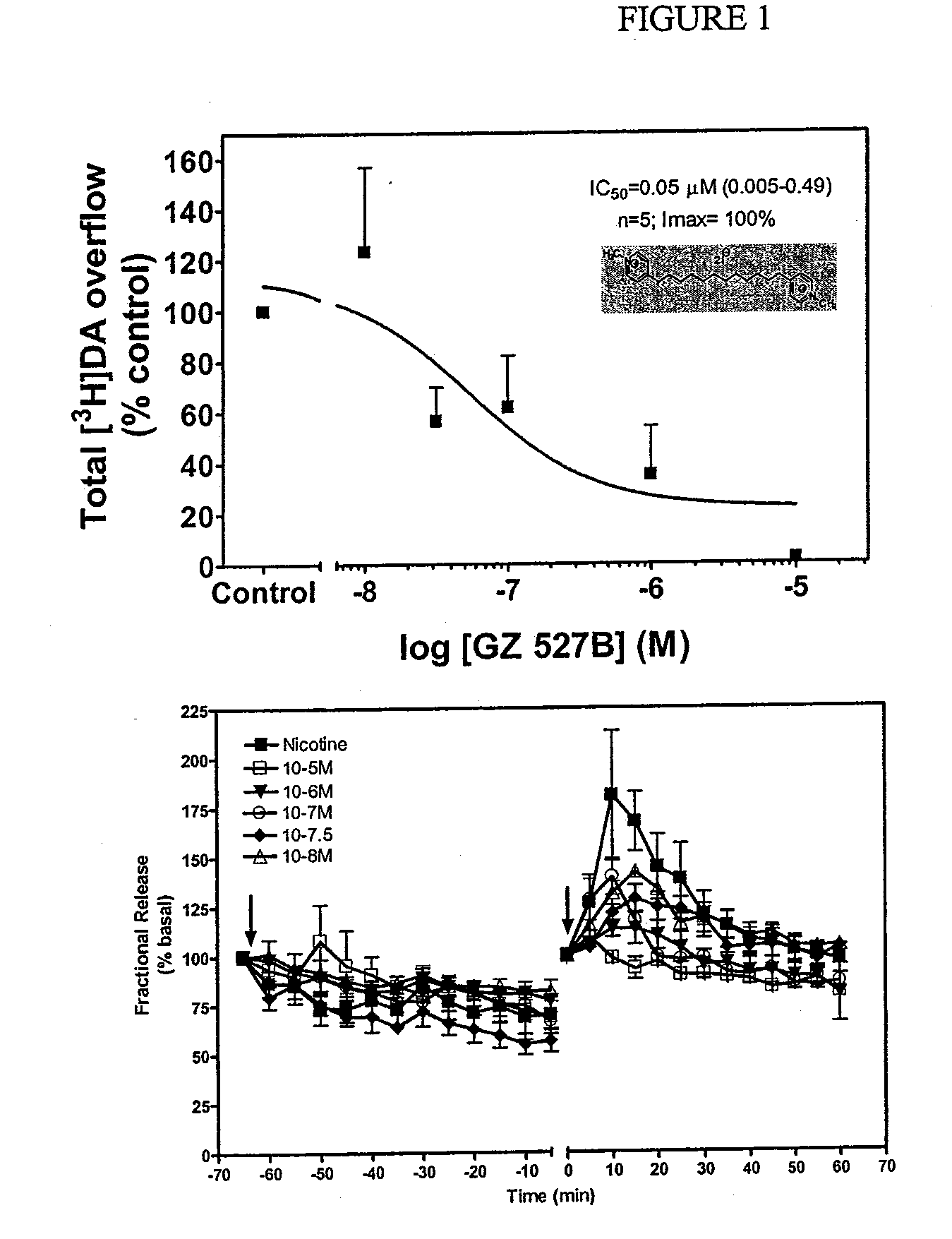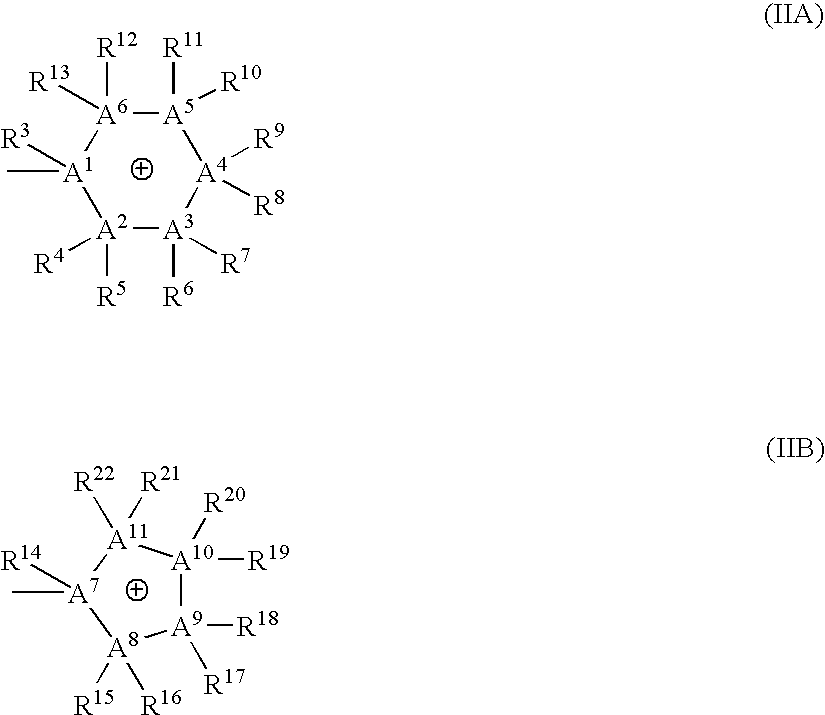Bis-quaternary ammonium salts and methods for modulating neuronal nicotinic acetylcholine receptors
a technology of nicotinic acetylcholine receptor and ammonium salt, which is applied in the direction of heterocyclic compound active ingredients, drug compositions, biocide, etc., can solve the problem of limited number of tools available to study the pharmacology of native receptors
- Summary
- Abstract
- Description
- Claims
- Application Information
AI Technical Summary
Benefits of technology
Problems solved by technology
Method used
Image
Examples
example 1
Preparation of 2,2′-(1,12-dodecanediyl)bispyridine
[0123]
[0124]LDA (2M) (20 mL, 40.00 mmol) was added dropwise to a solution of 2-picoline (3.73 g, 40.00 mmol) in THF (60 mL) at −78° C. The mixture was stirred for 30 min and then 1,10-diiododecane (6.31 g, 16.00 mmol) in THF (10 mL) was added dropwise. The resulting mixture was warmed to room temperature and stirred for 4 hrs. 50% saturated NH4Cl was added to the reaction mixture. The aqueous phase was extracted with ethylacetate (40 mL×2), and the combined organic liquors were washed with 50% saturated brine (40 mL×3) and saturated brine (40 mL), dried over anhydrous Na2SO4, and concentrated under reduced pressure. The crude product was purified by column chromatography (hexanes:ethylacetate 2:1 to 1:1) to afford 3.75 g of the title compound. Yield: 72%. 1H NMR (300 MHz, CDCl3) δ 1.13-1.42 (m, 16H), 1.60-1.81 (m, 4H), 2.78 (t, J=7.8 Hz, 4H), 7.08 (ddd, J=7.5, 5.1, 0.6 Hz, 2H), 7.13 (d, J=7.5 Hz, 2H), 7.57 (dt, J=7.5, 1.8 Hz, 2H), 8....
example 2
Preparation of N,N′-dimethyl-2,2′-(1,12-dodecanediyl)bispyridinium diiodide
[0125]
[0126]2,2′-(1,12-Dodecanediyl)bispyridine (370 mg, 1.14 mmol) was dissolved in acetone (15 mL). Methyl iodide (1.62 g, 11.40 mmol) was added and the mixture was stirred for 48 hrs at room temperature. The precipitate was filtered and washed with diethyl ether. The obtained pale yellow solid was dried under vacuum to give 643 mg of the title compound. Yield: 93%. 1H NMR (300 MHz, DMSO-d6) δ 1.17-1.50 (m, 16H), 1.60-1.78 (m, 4H), 3.06 (t, J=7.8 Hz, 4H), 4.27 (s, 6H), 7.95 (dt, J=6.9, 1.2 Hz, 2H), 8.01 (d, J=7.8 Hz, 2H), 8.49 (dt, J=7.8, 1.5 Hz, 2H), 8.95 (d, J=5.7 Hz, 2H) ppm; 13C NMR (75 MHz, DMSO-d6) δ 26.5, 28.6, 28.7, 28.9, 29.0, 31.8, 45.2, 124.9, 127.6, 144.9, 146.2, 158.3 ppm.
example 3
Preparation of 3,3′-(1,12-dodecanediyl)bispyridine
[0127]
[0128]LDA (2M) (20.40 mL, 40.80 mmol) was added dropwise to a solution of 3-picoline (3.80 g, 40.80 mmol) in THF (60 mL) at −78° C. The mixture was stirred for 30 min and then 1,10-diiododecane (6.43 g, 16.32 mmol) in THF (10 mL) was added dropwise. The resulting mixture was warmed to room temperature and stirred for 4 hrs. 50% saturated NH4Cl was added to the reaction mixture. The aqueous phase was extracted with ethylacetate (40 mL×2), and the combined organic liquors were washed with 50% saturated brine (40 mL×3) and saturated brine (40 mL), dried over anhydrous Na2SO4, and concentrated under reduced pressure. The crude product was purified by column chromatography (hexanes:ethylacetate 2:1 to 1:1) to afford 3.98 g of the title compound. Yield: 75%. 1H NMR (300 MHz, CDCl3) δ 1.17-1.40 (m, 16H), 1.53-1.68 (m, 4H), 2.60 (t, J=7.5 Hz, 4H), 7.20 (dd, J=7.8, 1.8 Hz, 2H), 7.48 (dt, J=7.8, 1.8 Hz, 2H), 8.43 (d, J=5.1 Hz, 2H), 8.44 ...
PUM
| Property | Measurement | Unit |
|---|---|---|
| Molar density | aaaaa | aaaaa |
| Molar density | aaaaa | aaaaa |
| Molar density | aaaaa | aaaaa |
Abstract
Description
Claims
Application Information
 Login to View More
Login to View More - R&D
- Intellectual Property
- Life Sciences
- Materials
- Tech Scout
- Unparalleled Data Quality
- Higher Quality Content
- 60% Fewer Hallucinations
Browse by: Latest US Patents, China's latest patents, Technical Efficacy Thesaurus, Application Domain, Technology Topic, Popular Technical Reports.
© 2025 PatSnap. All rights reserved.Legal|Privacy policy|Modern Slavery Act Transparency Statement|Sitemap|About US| Contact US: help@patsnap.com



